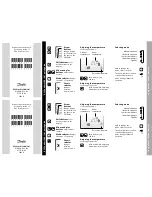
Actual signals and parameters 269
8117 NR OF AUX
MOT
Sets the number of auxiliary motors. Each auxiliary motor
requires a relay output, which the drive uses to send
start/stop signals.
The Autochange function, if used, requires an additional
relay output for the speed regulated motor.
The following describes the set-up of the required relay
outputs.
Relay outputs
As noted above, each auxiliary motor requires a relay
output, which the drive uses to send start/stop signals. The
following describes how the drive keeps track of motors and
relays.
The drive provides one relay output RO 1. An external relay
output module can be added to provide relay outputs
RO 2 … RO 4.
Note:
If five auxiliary motors are needed (Autochange
disabled), use transistor output TO (parameter
) in addition to relay outputs RO 1 … RO 4. In relay
order (= auxiliary motor order), TO is set between RO 1 and
RO 2 (see page
). Transistor output must be set to
is set to 0
). Note that maximum voltage at TO is 30 V DC.
define, respectively, how
relays RO 1 … RO 4 are used – the parameter value 31
) defines the relay as used for PFC.
The drive assigns auxiliary motors to relays in ascending
order. If the Autochange function is disabled, the first
auxiliary motor is the one connected to the first relay with a
parameter setting = 31 (
), and so on.
If the Autochange function is used, the assignments rotate.
Initially, the speed regulated motor is the one connected to
the first relay with a parameter setting = 31 (
), the first
auxiliary motor is the one connected to the second relay
with a parameter setting = 31 (
), and so on. The fourth
auxiliary motor uses the same reference step, low
frequency and start frequency values as the third auxiliary
motor.
1
0…4 (5 with TO) Number of auxiliary motors
1 = 1
All parameters
No.
Name/Value
Description
Def/FbEq
Aotewell Ltd
www.aotewell.com
Industry Automation
HongKong|UK|China
+86-755-8660-6182
















































